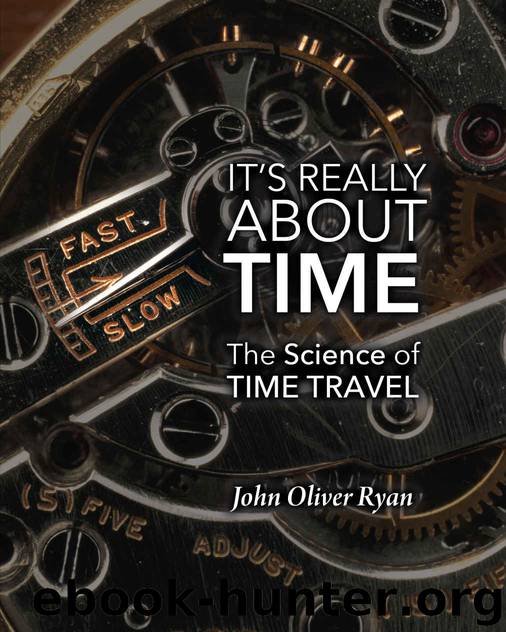It's Really About Time: The Science of Time Travel by John Oliver Ryan

Author:John Oliver Ryan [Ryan, John Oliver]
Language: eng
Format: azw3
Publisher: Tahilla Press
Published: 2020-02-03T16:00:00+00:00
Now all this is centuries-old physics and if you ponder it a little, it will make sense. But if you thought for example that the bullet should still have dropped straight downward from Liam’s perspective, wouldn’t it hit the floor 4 meters to the left of the hole since the train had moved that distance during the bullet’s flight? It would therefore have punched a second hole in the floor where it hit and that would really be crazy, because Lauren saw no such thing from within the carriage. The explanation is that from Liam’s perspective, when the bullet left the rifle’s muzzle it had two speed components; the rifle’s muzzle velocity that ejected the bullet vertically downwards and the train’s horizontal speed that the bullet possessed before it left the rifle’s muzzle; and both speed components were maintained (there being nothing to stop them) until the bullet buried itself in the ground beneath the train. Thus, the diagonal path of the bullet as seen by Liam.
Note that the speed of the bullet from Liam’s perspective has increased from 15 m/sec to 25 m/sec, which is why it could cover the 5-meter diagonal distance in the time it took to get from the ceiling to the floor of the carriage. This is another example of combining speeds, but there’s a difference. Recall that in the earlier train experiment with Lauren and Liam, the speed of the train was either added to or subtracted from the rifle’s muzzle velocity to get the speed of the bullet relative to the tracks. That’s because the two speeds were acting along the same line (co-linear), i.e., both were parallel to the railroad track. But in the present thought experiment, the two speeds are at right angles to each other, the bullet moving vertically downward and the train moving horizontally. In this case, instead of simply adding or subtracting them to get the resultant speed and direction of the bullet, we need to use a different method, which is really quite simple. Draw two lines at right angles to each other; make the lengths of two lines proportional to the two speeds to be combined; complete the rectangle; the length and direction of the diagonal is the resultant speed and direction of the bullet. For readers who’d like a fuller understanding of this, see appendix 3 (Composition of Velocities: Orthogonal Case).
The important takeaway from this experiment – and also from our earlier experiment in which Lauren fired a bullet out the front of a moving train – is that the speed of a material object (in both those cases, a bullet) relative to an observer can be affected if the device that ejected the bullet (the rifle) is itself moving, whether along the path of the bullet or indeed at any angle relative to the path of the bullet. In this experiment, the speed of the bullet relative to Liam had increased from the 15 m/sec muzzle velocity of the rifle to 25 m/sec, as
Download
This site does not store any files on its server. We only index and link to content provided by other sites. Please contact the content providers to delete copyright contents if any and email us, we'll remove relevant links or contents immediately.
Einstein For Dummies by Calle Carlos I(637)
Astronautics by Ulrich Walter(421)
Cosmology for the Curious by Delia Perlov & Alex Vilenkin(394)
Three Lectures on Complexity and Black Holes by Leonard Susskind(369)
Special Relativity and Classical Field Theory (Theoretical Minimum 3) by Leonard Susskind & Art Friedman(357)
The ABC of Relativity by Bertrand Russell(351)
Principles of Astrophysics by Charles Keeton(347)
Relativity Simply Explained by Martin Gardner(345)
Time Machine Tales by Paul J. Nahin(325)
Flatland: a romance of many dimensions (Illustrated) by Abbott Edwin Abbott(311)
The Classical Theory of Fields by Carl S. Helrich(311)
Applied Holography by Matteo Baggioli(293)
Srimad Bhagavatam (Complete Twelve-Cantos Set) by A. C. Bhaktivedanta Swami Prabhupada(291)
Darwin and Modern Science by A. C. Seward(291)
Flatland. A Romance of Many Dimensions by Edwin A. Abbott(286)
Introduction to General Relativity by Cosimo Bambi(258)
A Primer in Tensor Analysis and Relativity by Ilya L. Shapiro(256)
Smooth Manifolds by Rajnikant Sinha(256)
Relativity by Stannard Russell;(249)
